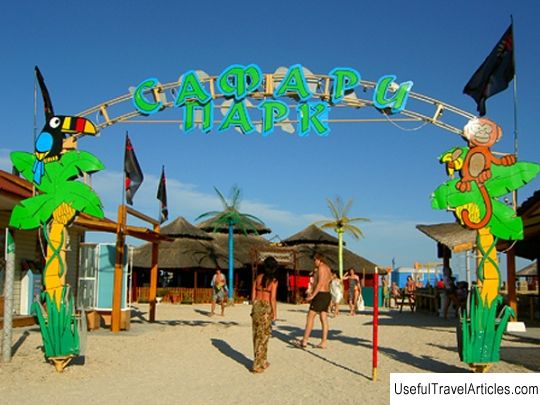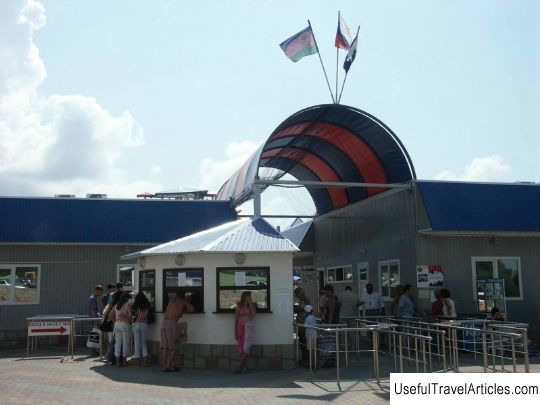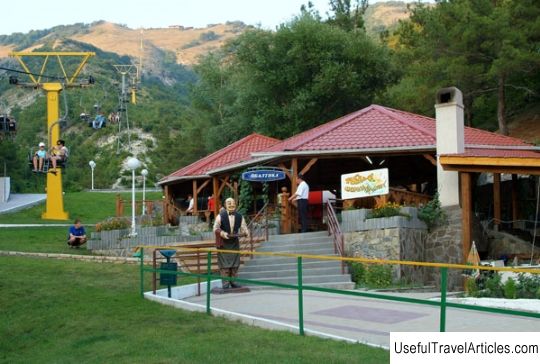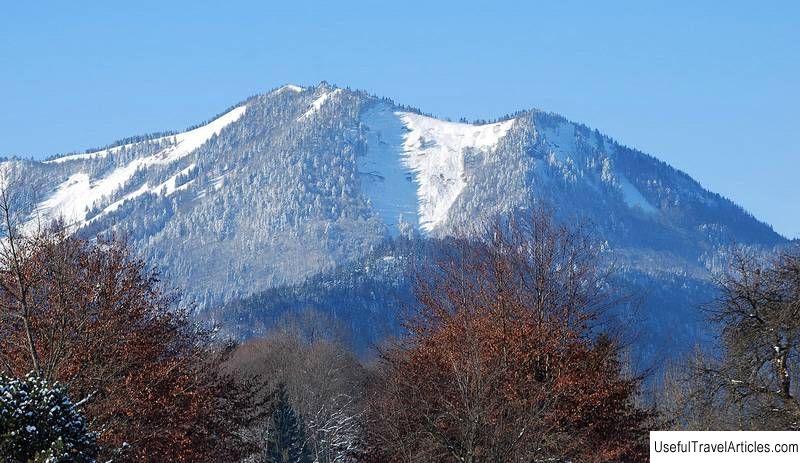Safari park description and photos - Russia - South: Gelendzhik
Rating: 8,7/10 (576 votes) 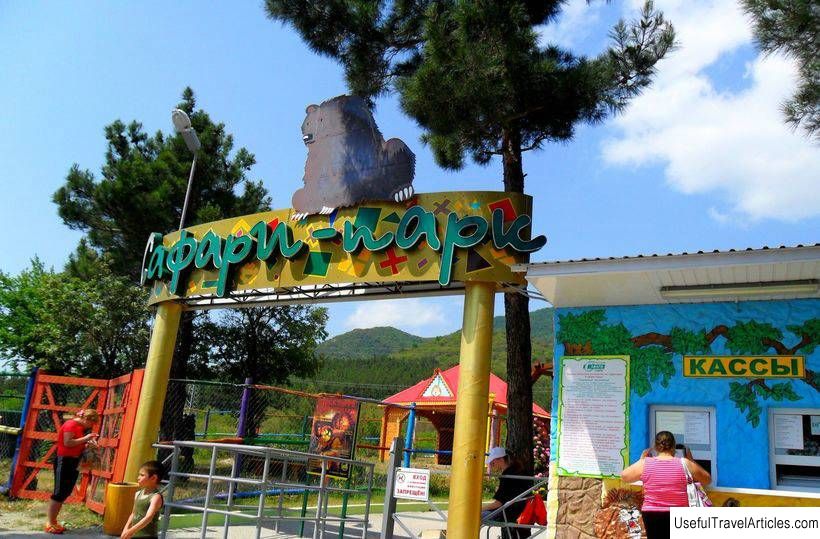
Safari park description and photos - Russia - South: Gelendzhik. Detailed information about the attraction. Description, photos and a map showing the nearest significant objects. Photo and descriptionSafari Park in Gelendzhik on the slope of the Markotsky ridge opened in 2004 and immediately became one of the main attractions of the city. This is a whole entertainment complex : a cable car, a huge zoo, a museum, playgrounds, attractions, cafes - you can spend the whole day here and not get tired. Cable carThe Safari Park cable car is the longest and highest on the entire Black Sea coast. Its height is 640 meters, and its length is 1600 meters . The entire journey over the mountainside and the zoo takes twenty minutes. It offers a magnificent view of the semicircular sea bay, mountains and herds of various ungulates grazing below, presented in the zoo. The journey is absolutely safe, but it is carried out not in the usual closed and glazed cabins, but in open ones, designed for two passengers. This allows you to make colorful shots without interference, but also delivers a thrill. In bad weather conditions, traffic stops. It is worth dressing warmly - it can be cool in open cabins. Upper Park The park is divided into Upper and Lower , on both sides of the lower cable car station. At the very top of the mountain, at the upper station, there is an observation deck from which you can enjoy the view of the surroundings. From here you can see the sea, mountain ranges and the park below. Fairy Tale Alley leads one way from the station through the playground with images of fairy-tale characters: Ruslan and Lyudmila, the Scientist's Cat, Baba Yaga, Nightingale the Robber and others. At the end of the alley there is a stone dolmen . Dolmens or "stone tables" are called ancient megalithic structures. Many mysteries are connected with them - until now no one knows, for what they were used, or how they were created. For example, the famous Stonehenge consists of similar dolmens. In the Caucasus, dolmens were built 4-5 thousand years ago. They were stone burial chambers with a round hole - this is exactly what you can see here. This dolmen is genuine, although it was originally located in a different place - it was specially brought here from the coast. On the other side of the upper station there are Jurassic Park with colorful sculptures of dinosaurs in full growth. Terrarium is also located here. Several types of snakes can be seen in it. These are mainly non-venomous pythons of various species, but there is also a real king cobra. There are lizards here: iguanas, basilisks, monitor lizards, skinks, as well as chameleons, frogs and toads and turtles. In addition, scorpions and tarantulas live here, and the main exhibit is the Nile crocodile family. Zoo Large enclosures occupy most of the territory of the Upper and Lower Parks. Its total area is 160 hectares, so the animal enclosures are large enough to feel almost free. Safari Park positions itself as a "rehabilitation center" for animals . Rare animals listed in the Red Book live here: Himalayan and brown bears, foxes, wolves, leopards, Ussuri tigers, wild boars, lemurs, etc. Almost each of the animals has its own history. For example, two Amur tigers , Homer and Jedi, when they were very young, were subjected to illegal and merciless exploitation - they were photographed with them, but they did not feed them or treat them. Before placing them here, the animals had to literally be saved from death. In the same way, cougars were saved from photographers from the Gelendzhik embankment. There is a lion , which in his youth performed in the circus, and when he stopped obeying, he ended up in the zoo. Now he is bouncing with tigers from neighboring enclosures. six brown bears got here from the circus - they are too old for a circus arena. The local chimpanzee John once served as a real croupier in a real casino - a monkey's intellect is enough for this. He knew how to spin the roulette, and also smoked, drank and earned diabetes mellitus from his difficult job - no one cared about his health. When the institution closed, he found himself on the street, and then, after a long treatment, in Safari Park. In addition to John's chimpanzees, the Monkey City is home to orangutans, monkeys, gibbons, eastern colobus and Madagascar lemurs Himalayan bears live in a huge aviary, over which a bridge is built - visitors can watch from above for their lives. An Indian elephant, polar bear, black panther, porcupine, mongooses, meerkats, lynxes and caracals live in the Lower Park. African oryx antelopes graze among the ungulates in the zoo, European fallow deer, red deer, roe deer, yaks, bison and maned rams. There is a bird's yard in the Lower Park. Owls, bald eagles, parrots, pheasants, peacocks, geese and ornamental chickens live here. And in the Upper Park there are already other birds - ostriches, pelicans and flamingos. For the smallest visitors in the Lower Park there is a " Ranch " with goats, ponies, donkeys and domestic rabbits. flora of the park is diverse. It is located on the slope of the Markoth Mountain. In translation, the word means "blackberry bracelet". Initially, the mountain was literally covered with thickets of blackberries and raspberries. Other shrubs that are resistant to dry climates also grow here: hawthorn, blackthorn, wild rose and Pitsunda pine. Once upon a time there were oak forests, but they were exterminated in the 19th century. In our time, more resistant pine trees have been planted - so the air in Safari Pak is fragrant and healing. The remains of relict juniper, hornbeams and beeches are preserved here, and the central areas of the park are decorated with flower beds with southern flowers. Bear's Cave One of the most interesting objects in the park is Bear's Cave . During the war, there was a bunker in an inconspicuous place on the slope. Now it has been turned into a karst cave. Despite the fact that it is made of concrete, the cave is indistinguishable from the real one. Its length is two hundred meters: there are several tunnels with branches and grottoes, in a word, a real cave labyrinth. There are stalactites and stalagmites - though they are made of concrete, and the multi-colored streaks on the walls, typical for karst caves, are a dye. It is always cold and humid here, the temperature never rises above twelve degrees, and a key spring feeds a small underground lake. So you should take warm clothes with you. The cave is densely populated: there are underground fish in the lake, one of the grottoes is occupied by butterflies - during the season you can see the process of their hatching from the cocoon. In another grotto live Nile fruit bats - bats, which are most often called "flying dogs", they are so big. Here is a exhibition of minerals and minerals from the Caucasus Mountains and the Black Sea coast, and in one of the most secluded corners, a real pirate treasure is hidden. The largest grotto is called the "Seventh Heaven". Steps lead up to its ceiling, so you can climb up to this sky. Maritime Museum The" Maritime Museum "presents models of various ships since antiquity, nautical navigation devices, pirate maps, a collection of coins and much more. Here is the real cabin of the Nautilus, in the windows of which you can see fish swimming by and even find the sunken Titanic. The museum presents a archaeological collection of finds from different times from the coast. Here were the Greek colonies lived Scythians and Sarmatians - and they all left behind ceramics, weapons, jewelry and household items. The museum is designed in such a way that it will be interesting even for the smallest visitors. Here you can take unique shots against the background of the exhibits, in a real diving suit, etc. One of the most photogenic exhibits is a model of a coral reef that occupies almost an entire hall. On the roof there is another observation deck, an exhibition of cannons and anchors, as well as giant sculptures of great travelers - Columbus, Magellan and others. Notes
       We also recommend reading Temple of Friendship in Pavlovsky Park description and photos - Russia - St. Petersburg: Pavlovsk Topic: Safari park description and photos - Russia - South: Gelendzhik. |


